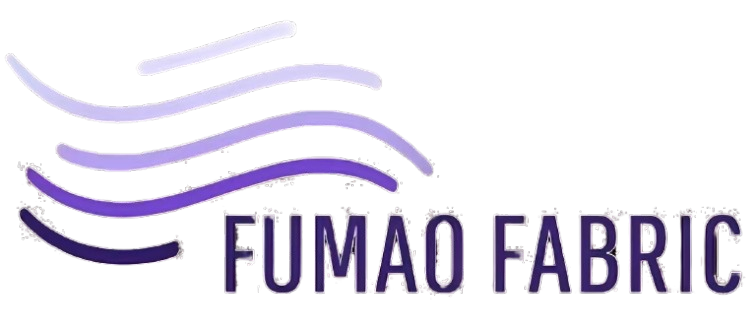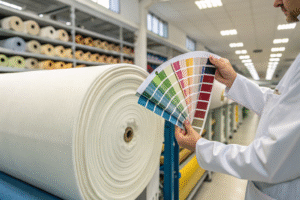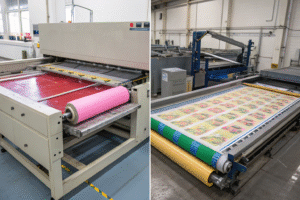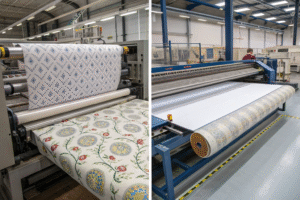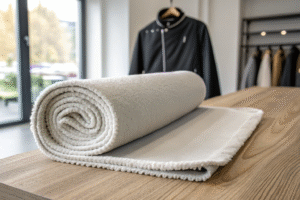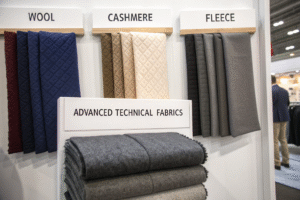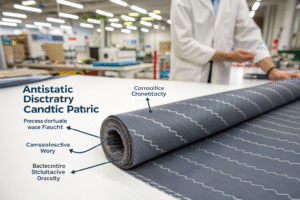When it comes to drapery in commercial or public spaces—such as hotels, theaters, schools, or offices—style alone is not enough. Safety is paramount. In many countries, especially the U.S., fire-retardant (FR) certification is not optional. As a fabric supplier, we’re constantly asked by international clients: “What kind of fire-retardant drapery fabrics can meet both code and design standards?”
Fire-retardant drapery fabrics are engineered or treated to reduce flammability, meet local fire codes, and maintain elegant aesthetics. From inherently flame-resistant fibers to treated natural fabrics, there are diverse options to suit every design brief and regulation.
In this guide, we’ll break down the different types of FR fabrics, their certifications, pros and cons, and what buyers need to consider when sourcing from China and exporting globally.
What Are the Main Types of Fire-Retardant Drapery Fabrics?
Not all FR fabrics are created equal. They fall into two main categories: inherently flame-retardant (IFR) and chemically treated. Each has different properties, costs, and lifespans.
The most common FR drapery fabrics include IFR polyester, Trevira CS, modacrylic blends, and treated cotton—each offering distinct flame resistance, texture, and certification paths.

What Is Inherently Flame-Retardant Polyester?
IFR polyester fibers are made with built-in flame-resistant chemistry at the molecular level. The FR properties never wash out or degrade, even after years of laundering or exposure to light.
Brands like Trevira CS and Avora FR lead the market in IFR fibers used for curtains in hotels, cruise ships, and schools. According to Textile Exchange, IFR fabrics can pass stringent NFPA 701, BS 5867, and DIN 4102-B1 standards.
How Does Treated Cotton or Blends Compare?
Natural fiber options like cotton and linen can be topically treated with flame-retardant finishes. These finishes, such as Proban® or Pyrovatex®, create a protective barrier. However, they may diminish with repeated washing or dry cleaning.
Westex explains how treatment durability depends on resin bonding and post-treatment care. For drapery in less high-risk environments, treated fabrics offer a balance of safety and affordability.
What Certifications Should Fire-Retardant Fabrics Meet?
Whether you’re outfitting a conference room or designing boutique hotel curtains, certifications are everything. Without the right labels, your shipment may face delays, rejections—or worse, liability risks.
Common certifications for FR drapery fabrics include NFPA 701 (US), BS 5867 (UK), DIN 4102-B1 (Germany), and EN 13773 (EU), with testing protocols for flame spread, smoke, and afterglow.

What Does NFPA 701 Require for Drapery?
NFPA 701 is the most recognized fire safety standard in North America for hanging textiles. It tests for ignition resistance, flame spread, and char length under controlled conditions.
Suppliers like SGS and Intertek provide certification testing services. Buyers must request test reports, not just verbal confirmation, when importing from overseas.
How to Verify European and UK FR Compliance?
In the UK, BS 5867 Part 2 Type B is the primary test for drapes. The EU follows EN 13773, which classifies flame spread in categories 1 to 5. German buyers often require DIN 4102-B1.
At Fumao Fabric, we issue QR-linked test reports per batch, so importers can easily show local authorities or fire marshals the compliance data on demand.
What Are the Key Features to Look for in FR Drapery?
FR fabric performance goes beyond resisting fire. Drapery must also hang beautifully, drape naturally, resist fading, and meet acoustic or blackout requirements.
When selecting FR drapery fabric, consider flame resistance, texture, weight, light fastness, wash durability, and aesthetics—especially for commercial interiors.

How Do Weight and Drape Affect Performance?
Higher GSM fabrics (250–400 GSM) typically perform better in blocking light and absorbing sound—especially when paired with blackout liners. IFR polyester with jacquard or dobby textures gives both performance and elegance.
Sources like Archiproducts and Designtex offer catalogs where you can filter for GSM, flame rating, and visual style in one interface.
Can FR Drapes Be Washed or Dry-Cleaned?
Yes, but it depends on the treatment. Inherently FR fabrics can be machine-washed repeatedly without losing performance. Treated fabrics may lose protection after 10–50 washes unless dry-cleaned carefully.
We always provide aftercare instructions and test laundering results per fabric. See Trevira’s guide for best practices on maintaining IFR curtain fabrics.
Where Can You Source High-Quality FR Drapery Fabrics?
The sourcing process starts with your end use—hospitality, corporate, education, or residential. Then, it comes down to fiber type, test standards, and lead times.
Work with mills that offer pre-certified FR fabrics, transparent test reporting, and support for custom dyeing or printing on compliant bases.

What Countries Specialize in FR Curtain Production?
- China: Polyester IFR and modacrylics at scale (especially Keqiao)
- Turkey: Decorative jacquard drapery with EU-compliant treatment
- India: Budget cotton and linen blends with Proban® coating
Search directories like Alibaba and Fibre2Fashion for verified FR-capable mills. At Fumao Fabric, we maintain over 100 stocked SKUs of FR curtain bases with certifications ready for export.
How to Ensure Batch-Level Compliance?
Always request:
- QR-coded lab reports with batch numbers
- Photos or videos of burn test from production
- Declarations of Conformity (DoC) for each region
- Labels sewn with “NFPA 701” or “EN 13773 Class 1” for customs
Platforms like UL Prospector help brands verify supplier certifications and safety declarations digitally before placing orders.
Conclusion
Fire-retardant drapery isn’t just a regulatory checkbox—it’s a blend of safety, performance, and design. From inherently FR polyester to treated natural blends, every space has a matching flame-safe fabric solution. By sourcing from experienced mills like Fumao Fabric, you ensure compliance, beauty, and peace of mind—without compromising your vision. As fire codes tighten and sustainability expectations rise, flame-retardant fabrics are no longer optional—they're essential.
